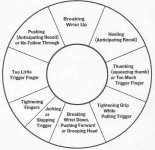Hi All
Wanted to see what everyone does to help tighten up their groups. I don't compete but am looking for drills/targets/techniques to use at the range to start dialing in my groups more.
I've been doing some dry fire and having a friend insert a dummy round into the mags to reduce flinching/anticipation.
Wanted to see what everyone does to help tighten up their groups. I don't compete but am looking for drills/targets/techniques to use at the range to start dialing in my groups more.
I've been doing some dry fire and having a friend insert a dummy round into the mags to reduce flinching/anticipation.

